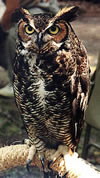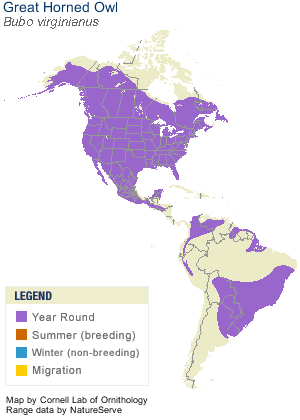
 Great Horned Owl
Great Horned Owl
Bubo virginianus
Education birds representing this species: Andre and Tonka - this species is also represented on the Exhibit Trail
Interesting Facts:
- "King of the Forest"
- Second largest owl in North America
- Only consistent predator of the skunk - has little to no sense of smell!
- All owls have feathers on their feet and it seems it serves many purposes - see June 5th update for details.
Physical Dimensions:
- wing span ~3.5-4.5 feet
- weight ~2-5.5 pounds (females larger)
Prey
- small mammals
- rabbits
- insects
- woodchucks
- geese
- herons
- scorpions
- other owls
- amphibians
- reptiles
Hunting Techniques:
- Mostly flies from perches next to open areas
- Silent flyers - surprises prey
Range:
- Nearly all of North America and parts of South America
- no regular migration - though individuals may wander if necessary

Color:
- no sexual dimorphism (when males and females differ in coloring). Sexual dimorphism is unusual in raptors.
Reproduction:
- Does not build its own nest - takes over abandoned crow, squirrel or hawk nests. Big sloppy stick nests, sometimes with oak leaves. Likes holes in trees, tops of dead trees/snags - 15-90 feet above ground.
- "Builds" nest in late January-May
1-4 eggs
30-37 days of incubation
"Branchers" at 6-10 weeks (stay in their birth tree and surroudning ground/shrubs)
Truly fledged at 10-26 weeks
Independent of parents at 6+ months old
Conservation:
- No conservation issues.